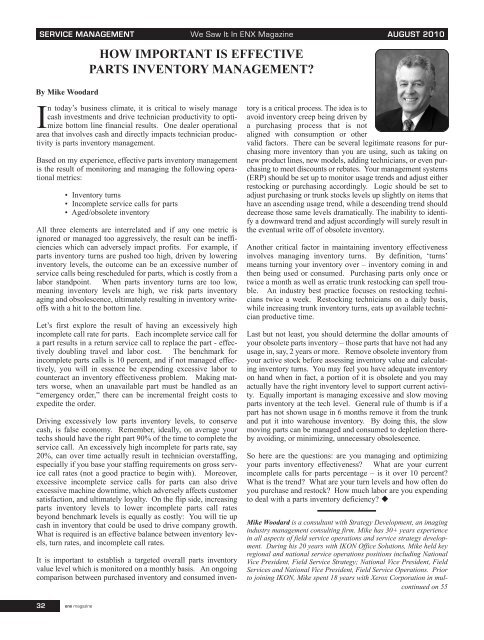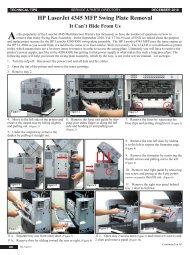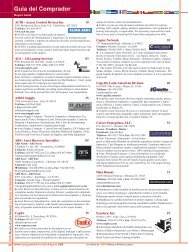You also want an ePaper? Increase the reach of your titles
YUMPU automatically turns print PDFs into web optimized ePapers that Google loves.
SERVICE MANAGEMENT We Saw It In <strong>ENX</strong> <strong>Magazine</strong> AUGUST <strong>2010</strong>By Mike WoodardHOW IMPORTANT IS EFFECTIVEPARTS INVENTORY MANAGEMENT?In today’s business climate, it is critical to wisely managecash investments and drive technician productivity to optimizebottom line financial results. One dealer operationalarea that involves cash and directly impacts technician productivityis parts inventory management.Based on my experience, effective parts inventory managementis the result of monitoring and managing the following operationalmetrics:• Inventory turns• Incomplete service calls for parts• Aged/obsolete inventoryAll three elements are interrelated and if any one metric isignored or managed too aggressively, the result can be inefficiencieswhich can adversely impact profits. For example, ifparts inventory turns are pushed too high, driven by loweringinventory levels, the outcome can be an excessive number ofservice calls being rescheduled for parts, which is costly from alabor standpoint. When parts inventory turns are too low,meaning inventory levels are high, we risk parts inventoryaging and obsolescence, ultimately resulting in inventory writeoffswith a hit to the bottom line.Let’s first explore the result of having an excessively highincomplete call rate for parts. Each incomplete service call fora part results in a return service call to replace the part - effectivelydoubling travel and labor cost. The benchmark forincomplete parts calls is 10 percent, and if not managed effectively,you will in essence be expending excessive labor tocounteract an inventory effectiveness problem. Making mattersworse, when an unavailable part must be handled as an“emergency order,” there can be incremental freight costs toexpedite the order.Driving excessively low parts inventory levels, to conservecash, is false economy. Remember, ideally, on average yourtechs should have the right part 90% of the time to complete theservice call. An excessively high incomplete for parts rate, say20%, can over time actually result in technician overstaffing,especially if you base your staffing requirements on gross servicecall rates (not a good practice to begin with). Moreover,excessive incomplete service calls for parts can also driveexcessive machine downtime, which adversely affects customersatisfaction, and ultimately loyalty. On the flip side, increasingparts inventory levels to lower incomplete parts call ratesbeyond benchmark levels is equally as costly: You will tie upcash in inventory that could be used to drive company growth.What is required is an effective balance between inventory levels,turn rates, and incomplete call rates.It is important to establish a targeted overall parts inventoryvalue level which is monitored on a monthly basis. An ongoingcomparison between purchased inventory and consumed inventoryis a critical process. The idea is toavoid inventory creep being driven bya purchasing process that is notaligned with consumption or othervalid factors. There can be several legitimate reasons for purchasingmore inventory than you are using, such as taking onnew product lines, new models, adding technicians, or even purchasingto meet discounts or rebates. Your management systems(ERP) should be set up to monitor usage trends and adjust eitherrestocking or purchasing accordingly. Logic should be set toadjust purchasing or trunk stocks levels up slightly on items thathave an ascending usage trend, while a descending trend shoulddecrease those same levels dramatically. The inability to identifya downward trend and adjust accordingly will surely result inthe eventual write off of obsolete inventory.Another critical factor in maintaining inventory effectivenessinvolves managing inventory turns. By definition, ‘turns’means turning your inventory over – inventory coming in andthen being used or consumed. Purchasing parts only once ortwice a month as well as erratic trunk restocking can spell trouble.An industry best practice focuses on restocking technicianstwice a week. Restocking technicians on a daily basis,while increasing trunk inventory turns, eats up available technicianproductive time.Last but not least, you should determine the dollar amounts ofyour obsolete parts inventory – those parts that have not had anyusage in, say, 2 years or more. Remove obsolete inventory fromyour active stock before assessing inventory value and calculatinginventory turns. You may feel you have adequate inventoryon hand when in fact, a portion of it is obsolete and you mayactually have the right inventory level to support current activity.Equally important is managing excessive and slow movingparts inventory at the tech level. General rule of thumb is if apart has not shown usage in 6 months remove it from the trunkand put it into warehouse inventory. By doing this, the slowmoving parts can be managed and consumed to depletion therebyavoiding, or minimizing, unnecessary obsolescence.So here are the questions: are you managing and optimizingyour parts inventory effectiveness? What are your currentincomplete calls for parts percentage – is it over 10 percent?What is the trend? What are your turn levels and how often doyou purchase and restock? How much labor are you expendingto deal with a parts inventory deficiency? uMike Woodard is a consultant with Strategy Development, an imagingindustry management consulting firm. Mike has 30+ years experiencein all aspects of field service operations and service strategy development.During his 20 years with IKON Office Solutions, Mike held keyregional and national service operations positions including NationalVice President, Field Service Strategy; National Vice President, FieldServices and National Vice President, Field Service Operations. Priorto joining IKON, Mike spent 18 years with Xerox Corporation in mulcontinuedon 5532enx magazine













